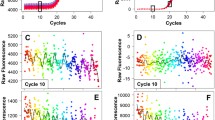Abstract
The effect of primer selection on real-time polymerase chain reaction (RT-PCR) performance was tested. Primer sets of varying length of product were used to amplify the sequence of β-actin. Variability in length caused variability in RT-PCR performance. Kinetic parameters of PCR were studied by mathematical approximation of real-time data by means of a four-parametric sigmoid model. This model describes the full kinetics of the amplification trajectory. Statistical exploration of parameters yielded by this model revealed that reactions with higher amplification efficiency – primed by well-performing primers – proceed with lower variability and are therefore better suited for measurement purposes.
Similar content being viewed by others
References
Gibson UE, Heid CA, Williams PM (1996) A novel method for real time quantitative RT-PCR. Genome Res. 6: 1095–1101.
Liu W, Saint DA (2002) A new quantitative method of real time reverse transcription polymerase chain reaction assay based on simulation of polymerase chain reaction kinetics. Anal Biochem. 302: 52–59.
Meijerink J, Mandigers C, van de Locht L, Tonnissen E, Goodsaid F, Raemaekers J (2001) A novel method to compensate for different amplification efficiencies between patient DNA samples in quantitative real-time PCR. J. Mol. Diagn. 3: 55–61.
Peccoud J, Jacob C (1996) Theoretical uncertainty of measurements using polymerase chain reaction. Biophys. J. 71: 101–108.
Pfaffl MW (2001) A new mathematical model for relative quantifi-cation in real-time RT-PCR. Nucl. Acids Res. 29: 2002–2007.
Rasmussen R (2001) Quantification on the LightCycler instrument. In: Meuer S, Wittwer C, Nakagawara K, eds. Rapid Cycle Real-time PCR: Methods and Applications. Heidelberg: Springer-Verlag Press, pp. 21–34.
Ririe KM, Rasmussen RT, Wittwer CT (1997) Product differentiation by analysis of DNA melting curves during the polymerase chain reaction. Anal. Biochem. 245: 154–160.
Schmittgen TD (2001) Real-time quantitative PCR. Methods 25:383–385.
Wittwer CT, Ririe KM, Andrew RV, David DA, Gundry RA, Balis UJ (1997) The LightCycler: a microvolume multisample fluorimeter with rapid temperature control. Biotechniques 22: 176–181.
Author information
Authors and Affiliations
Rights and permissions
About this article
Cite this article
Tichopad, A., Dzidic, A. & Pfaffl, M.W. Improving quantitative real-time RT-PCR reproducibility by boosting primer-linked amplification efficiency. Biotechnology Letters 24, 2053–2056 (2002). https://doi.org/10.1023/A:1021319421153
Issue Date:
DOI: https://doi.org/10.1023/A:1021319421153




